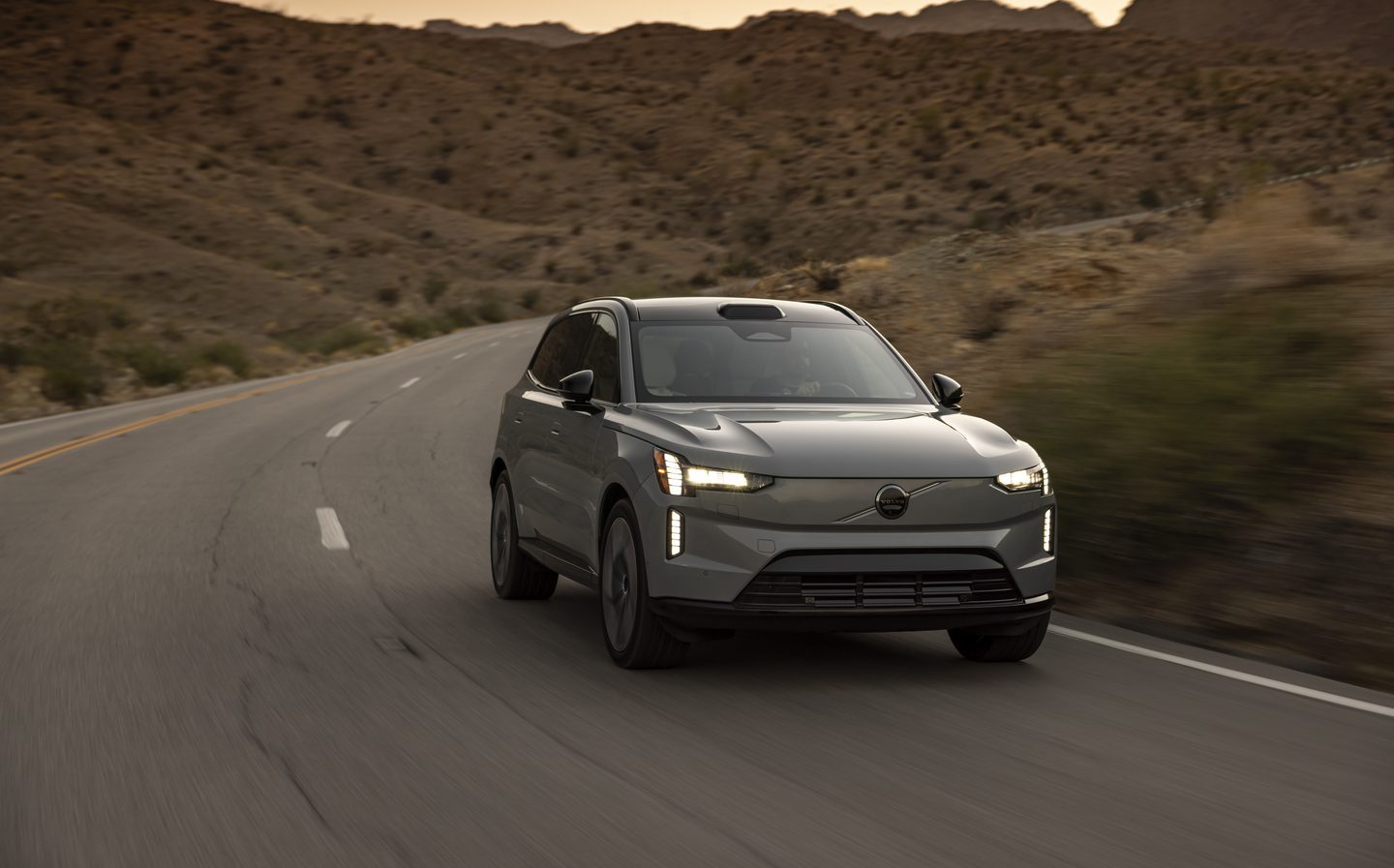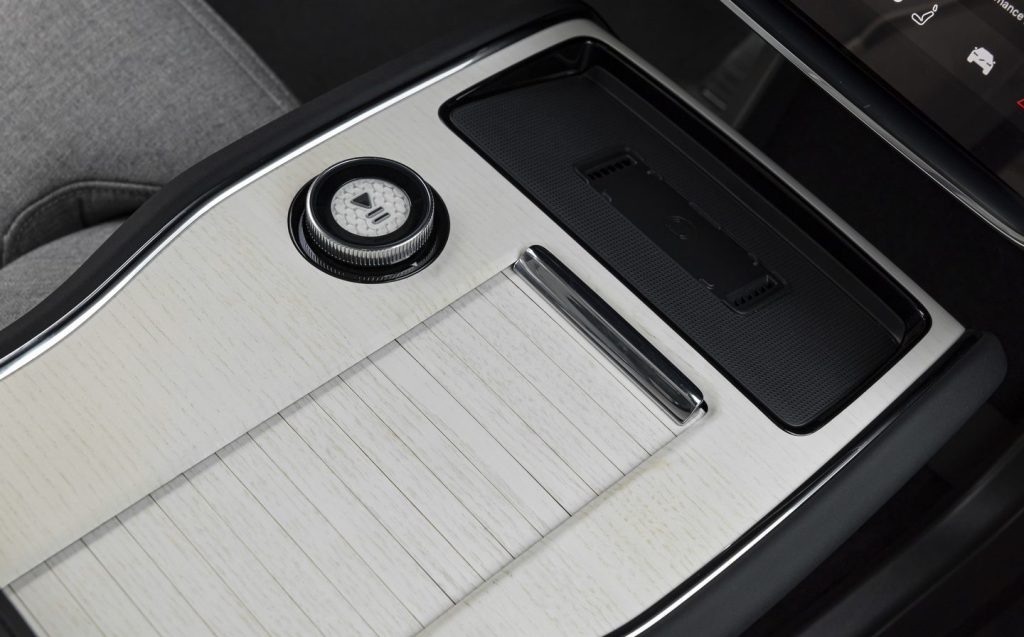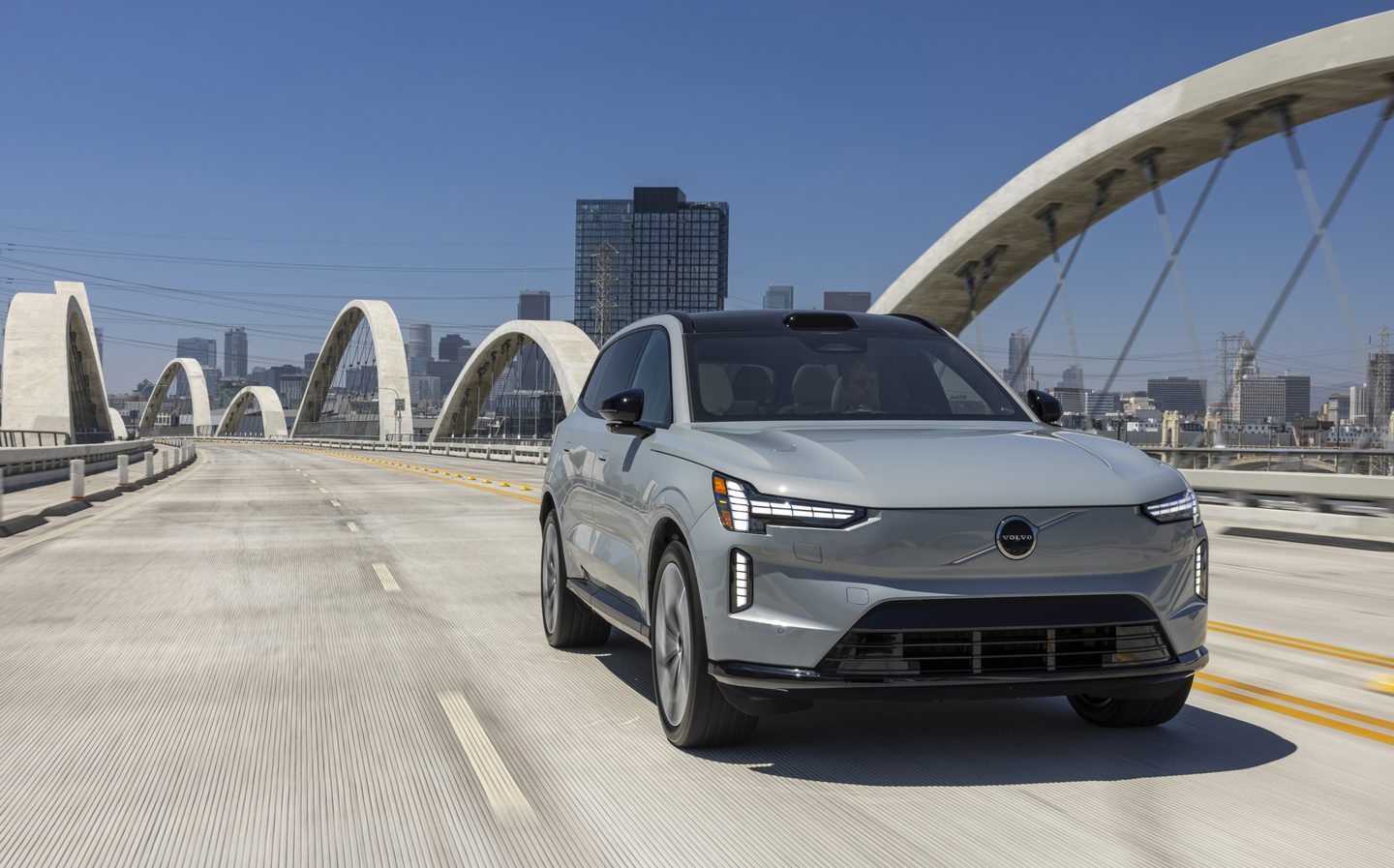Volvo EX90 2025 review: Swedish SUV beats Range Rover to market with electric seven-seater
Better than a Range Rover?
The most-read of all Jeremy’s Clarkson’s reviews published on Driving.co.uk* does not feature some exotic Italian hypercar or one of the bizarre creations he and his co-hosts dreamed up through the years on Top Gear and The Grand Tour. No, it’s far more sensible than that: the second-generation Volvo XC90.
Why? We can only guess, but we know why Clarkson loved it; according to Jeremy, the Swedish seven-seat family SUV is the only credible alternative to buying a new Range Rover.
Aptly, Volvo is stealing a march on JLR today by launching a pure-electric version of its big SUV first. It’s called the EX90 but clearly this has the XC90 at its heart and the new electric Range Rover in its sights.

You don’t need to be a paid-up member of the Volvo-spotting society to understand that you’re looking at a modern interpretation of the XC90. For starters, there’s little difference in overall size between the EX90 and the current XC90. The EX90 is 84mm longer than its combustion-engined relation and wider by 41mm, but the roofline is 27mm lower.
Even though the electric SUV looks the more curvaceous of the two it hasn’t strayed far from Volvo’s signature — and often wonderfully boxy — design heritage. Even if you stripped the badges off the non-existent front grille, you could tell this is a Volvo.

There are several modern touches, such as the pixellated LED headlights that present a fresh take on the company’s “Thor’s Hammer” lighting signature. These have motorised internals that make the car appear to blink when switching from main to high beams. This feature alone would make the Volvo a shoo-in for a role in any future Transformers movie. Best not think about replacement costs, though.
Then there’s the conspicuous bump on top of the windscreen. While Volvo has never wavered from its commitment to safety — from being the first company to install three-point seatbelts as standard to working towards a goal of having zero fatalities in its cars — it wants to remind everyone that it has always been at the vanguard when it comes to protecting its cars’ occupants.

To that end, the EX90 is built to be as future-proof as possible, hence the installation of a lidar sensor within that small roof dome. This laser-based lidar (light detection and range) sensor is not yet being fully utilised, as the driver assistance technology that will use its detailed information and road-reading abilities is still in development.
In time, Volvo intends to offer owners a more advanced version of its existing Pilot Assist system, which could be capable of providing hands-off driving in certain environments. Elon Musk may disagree but lidar’s capability to scan the road ahead over long distances and in varying types of weather conditions makes it a superior technology over what is currently commercially available.
You still get plenty of usable tech in the EX90 today, including the aforementioned Pilot Assist, which uses a suite of sensors for its adaptive cruise control. The driver will still need to pay attention to the road, of course, and hold the steering wheel, but Pilot Assist can take care of steering, lane keeping and recognising the speed limits, as well as acceleration and braking in both free-flowing and stop-start traffic.

There are similar systems in plenty of other cars these days but Pilot Assist is one of the more refined and natural feeling. Activating it is as simple as tapping the drive selector down an extra time and, once active, the system does the rest. Drivers can adjust the speed limit manually and take over at any moment.
Of course, all this safety tech is designed to protect your loved ones inside the massive cabin. And it is massive. Many cars profess to be seven-seaters but in reality are often more “five-plus-two” set-ups, which provide comfort for only the tiniest of people in the rearmost seats.
Not so the EX90; as in the XC90, its three-row arrangement can accommodate adults in every position; perhaps not taller adults in the third row, admittedly, but adults nonetheless. And kids will find it massive inside.
The second row comprises three individual seats that can all move independently, and the outer seats easily tilt and slide forwards to provide access to the third row. Back there, the seats are of similar size and space to those in the XC90, with only slightly less headroom in the EX90, but once the second-row seat is moved forward a bit there’s sufficient space for those of average height.

The vast panoramic glass roof helps alleviate any sense of confinement in the third row, and passengers there still get cup holders, air vents and USB-C charge ports on each side. Little ones can also travel in row three as both seats — as with the two outer seats in row two — are equipped with Isofix mounting points.
Another boon to parents of younger children is the integrated booster seat in the middle of the second row; the seat base unlatches and slides up into place to form a useful integrated booster.
It’s also worth noting that even when all seven seats are in use, the EX90 retains a usable boot space that measures 324 litres. That’s not far off what you get in an average small hatchback. The third-row seats can be electrically folded flat into the floor via buttons on the right side of the boot and raised again as needed. If you need to load bulkier items, the second row will also fold flat providing a massive 1,288 litres of cargo volume and, thanks to the EX90’s trick air suspension, owners can lower the rear of the car to make it easier to access.

The interior has a minimalist look with gorgeous materials throughout. Volvo’s “Nordico” upholstery is a sustainable material that’s similar to leather and comes in three colours. Volvo also offers a wool blend that is made of recycled plastics and sustainably sourced natural wool, which has a lovely look and feel.
Up front the simple, “reductionist” design makes the EX90 feel modern without being overly techy. Its three-spoke steering wheel is a decent size, isn’t overly thick-rimmed and has two banks of physical buttons with a capacitive layer for controlling driver assistance systems and media on the left and right side, respectively.

Other than these, the only other physical controls are a rotary controller on the centre console for volume and music functions and some safety-related buttons on the roof.
Ahead of the driver is an 8in display that has driving info including map guidance and visualisation of the surrounding traffic for the Pilot Assist function. Dominating the centre of the dashboard is the 14.5in portrait-style touchscreen. Volvo uses a Google-based operating system, so you get Google Maps that includes real-time traffic info thanks to its connected services.
There is also a host of different apps that can be added, and you can run Android Auto and Apple CarPlay if you prefer to mirror your phone onto the screen. The overall layout has a sense of familiarity to the XC90’s, but the design execution is cleaner and of course Volvo still offers some of the most comfortable driving seats in the market.
You won’t even need a physical key for the EX90 as Volvo uses UWB (ultra-wide band) technology to enable a digital key to be held within your smartphone, so all you need to do is have it on your person as you approach the car and it will unlock and be ready to drive away. Simply get in, put your foot on the brake pedal and tap down on the drive selector to move away.

Even as you begin to drive away, the Volvo delivers its first “wow” moment. We’re used to electric cars being quiet by now, but the EX90 is supremely hushed when on the move. You immediately feel calm when driving, as you’re insulated from the outside world in the cosseting environment that Volvo has created. Even the indicator sound is subtle.
You waft along in near silence, with only the faintest of road noise seeping into what feels like a hermetically sealed cabin. That’s thanks to the use of extra thick glass, and door frames that sit flush with the glass to reduce any undesirable wind buffeting. This cathedral-like silence demonstrates how well put together the EX90 is, as throughout our extensive test drive there wasn’t a single squeak or rattle from the interior, underlining how this Volvo is now a true competitor for the established luxury set.
Despite its vast size, and without any rear-wheel steering, the EX90 isn’t difficult to manoeuvre in tighter confines, helped by an array of cameras. The Twin Motor Performance model is the more potent of the two dual-motor powertrains, yet its power delivery is very manageable.
For the most part it primarily uses the electric motor on the front axle, and then brings in the rear-axle motor — the more powerful of the two — as it’s needed, such as if traction is lost at the front or increased performance is called upon. A sizeable 107kWh battery (that’s the usable energy capacity figure) is sufficient to make any range anxiety melt away as quickly as your stress levels do when in the sublime driver’s seat.

Officially the EX90 will cover up to 374 miles on the WLTP combined cycle and, during our time with the car, it gave us little reason to doubt it was capable of achieving that in mild conditions. Colder weather and running at high speed for long distances will negatively affect range, so as ever, try before you buy.
Naturally, everyone has a different set of driving habits and needs, and for some, going pure electric might be a step too far at this time. Volvo knows this, which is why it is also renewing its XC90 with fresh styling and improved hybrid powertrains.
But it’s worth noting that the EX90 is built on entirely new underpinnings, rather than being an XC90 with a battery sandwiched into the floor. That new architecture includes adaptive air suspension that can alter the car’s ride height, lowering it as the speed increases to improve aerodynamic efficiency. Drivers can also choose between soft and firm settings, with the former providing a pleasingly plush ride quality, even on massive 22in wheels.

And despite the hushed interior, drivers won’t feel completely isolated from the road, as the electrically assisted steering can, like the suspension, be set to soft or firm settings. The latter adds a little more weight, but not artificially so. However, we found the soft setting to be preferable as it felt lighter while retaining a good degree of communicative feedback through the steering wheel.
That natural feeling is one of the EX90’s winning traits, just as how the body rolls ever so slightly in the bends. It always feels stable and secure, but it’s pleasing that Volvo hasn’t tried to follow many other manufacturers and make it feel overly sporty by attempting to eliminate any semblance of body movement.

The whole package feels extraordinarily well executed, as it ought to given its starting price of just over £96,000. That’s upwards of £20,000 more than a Range Rover Sport and puts it much closer to Range Rover money. That might shock some people but what might shock others more is just how good it is to drive in comparison to those alternatives.
Volvo only offers the EX90 in one specification grade for now, meaning you get almost everything included as standard; only minor accessories such as mud flaps, heavy duty mats or a tow bar will cost you extra.
Few cars offer such a breadth of technology, safety, versatility and sheer class as this latest Volvo does. But as it’s pure-electric we wonder if Clarkson, who famously dislikes EVs, will find it worthy of his stamp of approval.
* Clarkson reviews no longer appear on Driving.co.uk; they’re exclusively available to subscribers of The Times and Sunday Times
Chinese carmakers
Volvo is a Swedish brand with headquarters in Gothenburg. It is owned by Geely, a privately-owned Chinese car giant. Buyers ought to be aware that Chinese car makers, however independent they claim to be, have been criticised for receiving an unfair advantage through WTO rule-breaking state support, from a political regime that Amnesty International reports carries out torture, genocide and routine suppression of dissent.
Related articles
- If you found our review of the Volvo EX90 interesting, you might like to read a review of its little sibling, the Volvo EX30
- You may also want to read our review of the updated Volvo XC40 and C40 Recharge
- Looking for other options to go electric? Here are the top 10 longest-range electric cars
Latest articles
- Your car’s worn tyres could be being burnt illegally in India, investigation reveals
- Open-top 214mph Aston Martin Vanquish Volante is world’s fastest blow-dry
- F1 2025 calendar and race reports: The new Formula One season as it happens
- Alfa Romeo Junior Ibrida 2025 review: Hybrid power adds an extra string to crossover’s bow
- Top 10 longest-range electric cars: all with over 400 miles per charge (officially)
- Renault 5 Turbo 3E ‘mini supercar’ confirmed with rear in-wheel motors producing 533bhp … and insane levels of torque
- British firm Longbow reveals ‘featherweight’ electric sports cars with 275-mile range
- Toyota and Lexus preview nine new EVs, starting with C-HR+ and revamped bZ4X
- Opel Grandland PHEV 2025 review: Smooth and efficient … but won’t get a Vauxhall badge
























